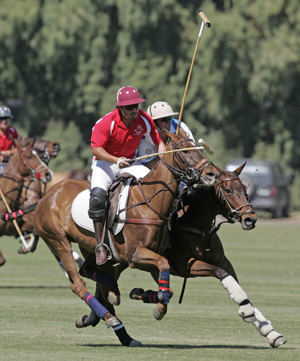Polo Teams and the Positions of the Players
by Alex Webbe
http://www.polo101.com
One of the oldest team sports in the world, polo can be confusing to the uninitiated, and confusing to watch without a basic understanding of the positions and responsibilities of the players.
A polo team is made up of four players. The players wear jerseys numbered 1-4. Those are not only the numbers assigned to the players but reflect their corresponding positions as well.
The Number 1 is a forward, and attacking offensive player similar to a wing in hockey or a forward in soccer, and, played correctly, one of the most disciplined positions in the game, because not only must the Number keep the team attack stretched out, he must remain out in front of the alignment even when the ball does not come forward (because inevitably, the moment a player turns around and goes back for the ball, it will be driven forward, catching him out of position). Not only is the Number 1 responsible for scoring goals, he is also expected to “ride-off: the opposing defensive player allowing a trailing teammate the opportunity to score-similar to a blocking back in football (he takes a beating blocking opposing players out of the way, but gets no credit for the goal he allows his teammate to score except by his own teammates). The Number 1 should be an accurate hitter and concentrate on scoring opportunities. At the same time, he must also bear defensive responsibilities for the opposing player (the opposing Number 4).
The Number 2 is also primarily an offensive player who is expected to be able to turn quickly and follow the lead of the Number 1 in order to be in position to pick up a drop pass or tack advantage of a missed or blocked shot. He should be one of the top mounted players on the team as he will be expected to cover a great deal of ground in the course of the match. He is one of the top two players on the team. His defensive responsibility is the opposing Number 3.
The Number 3 is usually the strongest player on the team and the field general. The Number 3 attacks the opposing offense and turns the ball upfield, usually with a pass ahead to his Number 1 or Number 2. The Number 3 must be able to hit long distances with accuracy and also have great hand-eye coordination allowing for the deft control of the ball. The Number 3 will also aid in defense, taking the opposing Number 2 or offering defensive support to his Number 4.
The Number 4 or “Back”, as he is often referred to, is the most defensive-minded player on the team. His responsibility is to defend his team’s goal and he should be able to turn opposing shots at goal aside, or completely reverse the direction of the ball with a powerful backshot. When opportunities arise, the Number 4 might also carry the ball forward, passing the Number 3 and/or Number 2 for a shot at goal himself, but his main responsibility remains defensive in nature, and his opposing player is the Number 1.
These roles are flexible, however, and in the course of a game players will interchange positions until they have the opportunity to return to their place on the field.
Properly employed, the ongoing interaction between the players might resembe a wheel, with players interchanging places with one another the length of the field.
It must also be remembered that as important as scoring might be in polo, the mantra of the game remains “man, line, ball”, making the opposing player the number one responsibility. The “line” of the ball, or the right-of-way (which in many cases determines infractions if it is crossed by an opposing player) is second in importance. Finally, the ball comes into play. Because of these priorities, you will observe the opposing players riding in pairs, side by side, up and down the field.


